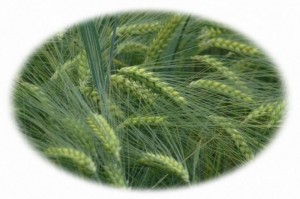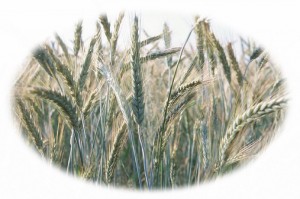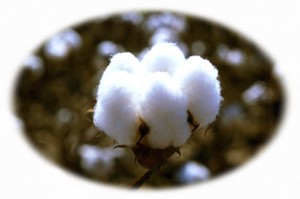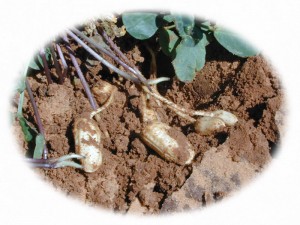This section includes cereal grains (Crop Group 15), cotton, and oil seed crops (Miscellaneous Crops/Group 20). Small grains used for grazing are summarized in the Forage Crop Grass section (Group 17) and Table 16. Asterisks indicate representative crops for the Group.
 Barley. An excellent feed ingredient; planted 10,000 to 20,000 acres in the High Plains and Trans Pecos areas. About 6,500 acres harvested for livestock feed, mostly in the Trans Pecos area. Pests include winter annual broadleaf weeds, foliar insects, rusts and powdery mildew, and sometimes a rodent looking for a malt.
Barley. An excellent feed ingredient; planted 10,000 to 20,000 acres in the High Plains and Trans Pecos areas. About 6,500 acres harvested for livestock feed, mostly in the Trans Pecos area. Pests include winter annual broadleaf weeds, foliar insects, rusts and powdery mildew, and sometimes a rodent looking for a malt.
Corn – for grain and silage*. (See section on Miscellaneous Crops for details on food grade corn, popcorn and sweet corn). Warm season, deep-rooted grass with monoecious (separate) flowers. Originated in Mexico (a New World crop). Now hybrids are bred for efficient production in temperate regions of the world. In Texas, corn is planted in all major regions – 50% is irrigated; 100,000 acres is harvested as silage for nearby feed lots in High Plains and dairies in Central Texas. Seed is also cleaned and bagged for feeding deer and other wildlife in Hill Country. Insect pests include aphids, grasshopper, corn earworm, corn root worms (Mexican, southern, and western), corn borers (European and southwestern), and fall armyworm. Weeds include annual broadleaf, grasses, and perennials; GMO hybrids are common (66%) in most regions. Diseases include several ear rots, leaf blight, common smut, rust, root and stalk rots, and some aflatoxin and fumonisin. See crop brief for more pests and pesticide use.
Millets. Millets are planted on 12,000 to 20,000 acres in High Plains region for grain. Foxtail millet (Setaria) grown for bird seed. Proso millet (Panicum) occasionally planted (1,500 acres) for grain when a short-season crop is needed. Japanese millet (Echinochloa) is grown for wildlife food plot production. (See Table 20 on Non-Food Crops). Bird problems are common and sometimes severe. An important drought tolerant crop for human food in arid regions of West Africa. Pests include seed-head insects. Weeds include warm-season annual grasses. Diseases are of less consequence in arid southwestern U.S. but some downy mildew and ergot. Also, see pearl millet (Pennisetum) for grazing or harvested for hay in Forage Grass section.
Oats. Although once a major feed grain, acreage declined with draft horses. Typically 600,000 to 750,000 acres are planted for winter grazing, mostly for stocker calves in Central and South Texas where freeze damage is of less concern and early fall grazing is desired (see “Forage Grasses – small grains” for details on grazed oats). About 125,000 acres are harvested for seed and special varieties for human food or other uses. Insect pests include fall and beet army worms and grasshoppers. Weeds include winter annual grasses and mustard. Diseases include rusts (usually plant resistant varieties) and viruses.
 Rice*. In contrast to the short and medium-grain rices grown in Asia, Texas produces an extra-long grain paddy rice for high-end domestic and export markets. A small acreage of aromatic or basmody rice. Although acreage in the ten upper Gulf Coast counties has declined 50% since the 1970s, yields have increased due to genetics, pest resistence, water management, and ratoon (second crop) production. RiceTec, in Alvin, Texas, operates a molecular breeding program for hybrid rice development. Red rice, a genetic contaminant, lowers quality and is extremely difficult to control. Insect pests include rice water weevil, rice stink bug, and grasshoppers. Diseases include sheath blight, crown rust, and blast. Weeds include water-tolerant grasses, broadleaves, and red rice. More details on pesticide use and pests are in crop brief.
Rice*. In contrast to the short and medium-grain rices grown in Asia, Texas produces an extra-long grain paddy rice for high-end domestic and export markets. A small acreage of aromatic or basmody rice. Although acreage in the ten upper Gulf Coast counties has declined 50% since the 1970s, yields have increased due to genetics, pest resistence, water management, and ratoon (second crop) production. RiceTec, in Alvin, Texas, operates a molecular breeding program for hybrid rice development. Red rice, a genetic contaminant, lowers quality and is extremely difficult to control. Insect pests include rice water weevil, rice stink bug, and grasshoppers. Diseases include sheath blight, crown rust, and blast. Weeds include water-tolerant grasses, broadleaves, and red rice. More details on pesticide use and pests are in crop brief.
Rye. Produced for confectionery use and flour commonly in Dawson and Gaines counties in the southern High Plains. Also seeded in narrow strips in the southern High Plains to reduce wind erosion prior to planting cotton, peanuts, or other irrigated crops. Pests are similar to those of wheat and include rusts and powdery mildew. Rye is planted on an additional 150,000 acres in east and northern Texas for winter grazing. “Cereal rye”, a small grain, should not to be confused with ryegrass, a forage species.
Sorghums. For grain and silage*. A native of east Africa. Hybridized in 1950s at Chillicothe, Texas, which revolutionized production and led to Texas’ massive feed lots in the High Plains. Now grown in world-wide temperate and tropical areas for grain, forage, and stalks. In Texas, sorghum is grown in all major regions and supports the beef, dairy, and poultry industries of the state. Sorghum for grain is grown on 3.5 million acres – both irrigated and rain-fed. Sorghum for silage or green chop is grown on an additional 0.5 to 1.0 million acres, mostly in the High Plains and Central Texas areas for beef and dairy (see Forage Grass section). Crop is more drought tolerant and requires less fertilizer and pesticide inputs than corn. Grain production near the Gulf Coast is exported. Pests include midge, green bugs (aphids), head worm complex, and soil insects. Weeds include summer annual grasses and johnsongrass. Diseases include head smut and several other foliar and stalk diseases. Sweet Sorghum is included in Miscellaneous Crops in Group 20.
Triticale. A doubled chromosome cross between wheat and rye, triticale (trit-ta-kay-lee) offers cold hardiness, good grazing, and resistance to most diseases and insect pests. Planted for grazing, and gaining acceptance in federal farm programs. Small amount of food-quality triticale is produced under contract and milled for specialty flour for health food advocates. Diseases are similar to those of wheat. Few pest problems except winter annual weeds. See sorghum brief for more details.
 Wheat*. Wheat is planted on 6 to 6.6 million acres annually in the High Plains (Plainview and north), Rolling Plains (Abilene to Wichita Falls), and Central Blacklands. But, depending on grain and beef prices, 45 to 65% of the crop may be “grazed out” by stocker calves and harvested as forage, not for grain (see “Forage Grasses – Small Grains”). Hard red winter wheat is planted in HP while soft wheat is seeded for grazing in other areas. Other wheats, such as club (for crackers), durum (for pastas), spelt (for baked goods) are not produced in Texas. Pests include aphids (green bugs), Hessian fly, white grubs, and army worms. Diseases include rusts, root rots, and leaf and head diseases. Field bindweed is a major problem. Varieties are bred to resist foliar diseases. See crop brief profile for more details.
Wheat*. Wheat is planted on 6 to 6.6 million acres annually in the High Plains (Plainview and north), Rolling Plains (Abilene to Wichita Falls), and Central Blacklands. But, depending on grain and beef prices, 45 to 65% of the crop may be “grazed out” by stocker calves and harvested as forage, not for grain (see “Forage Grasses – Small Grains”). Hard red winter wheat is planted in HP while soft wheat is seeded for grazing in other areas. Other wheats, such as club (for crackers), durum (for pastas), spelt (for baked goods) are not produced in Texas. Pests include aphids (green bugs), Hessian fly, white grubs, and army worms. Diseases include rusts, root rots, and leaf and head diseases. Field bindweed is a major problem. Varieties are bred to resist foliar diseases. See crop brief profile for more details.
Oilseed Crops
 Cotton*. Upland cotton (Gossypium hirsutum) is the major cash crop of Texas; grown on 4 to 6 million acres in all major regions of the state but 76% of the acreage is within 100 miles of Lubbock. Total acreage varies annnually due to price, weather outlook and farm programs. Estimated that 62% of the 2004 acreage was GMO, with glyphosate herbicide resistance and/or the Bt trait toward worms. Insect pests includes boll weevil (now in remission with the Boll Weevil Eradication Program), boll worms, bud worm, fleahopper, plant bug complex, thrips, aphids, and numerous occasional and secondary pests. Weeds include perennials, nightside, and nutsedge. Diseases include damping off, cotton root rot, bacterial blight, and root knot nematode. 100% of the planting seed is treated with a protective fungicide. ELS/Extra Long Staple cotton (G. barbadense) is produced on 18,000 acres in Far West Texas, similar to that in Arizona and California. Cotton crop profile and cotton brief show more details on pests, scouting, and pesticide use.
Cotton*. Upland cotton (Gossypium hirsutum) is the major cash crop of Texas; grown on 4 to 6 million acres in all major regions of the state but 76% of the acreage is within 100 miles of Lubbock. Total acreage varies annnually due to price, weather outlook and farm programs. Estimated that 62% of the 2004 acreage was GMO, with glyphosate herbicide resistance and/or the Bt trait toward worms. Insect pests includes boll weevil (now in remission with the Boll Weevil Eradication Program), boll worms, bud worm, fleahopper, plant bug complex, thrips, aphids, and numerous occasional and secondary pests. Weeds include perennials, nightside, and nutsedge. Diseases include damping off, cotton root rot, bacterial blight, and root knot nematode. 100% of the planting seed is treated with a protective fungicide. ELS/Extra Long Staple cotton (G. barbadense) is produced on 18,000 acres in Far West Texas, similar to that in Arizona and California. Cotton crop profile and cotton brief show more details on pests, scouting, and pesticide use.
 Peanuts*. Texas ranks second in the U.S. in peanut production. Acreage has shifted to West Texas where 76% of the crop is produced south and east of Lubbock; 72% are runner types and 13% are Spanish, with some Virginia (12%) and valencia types (3%). Insects include thrips, lesser cornstalk borer, southern corn root worm, burrowing bug, and armyworms, but less than 25% of crop is actually sprayed. Weeds are pigweed, yellow nutsedge, morningglory, johnsongrass, nightshade, Texas panicum, sunflower, purslane, Russian thistle, and eclipta. Herbicides are applied on 93% of the acreage; mostly pendimethalin (Prowl), metolachlor (Dual), imazapic (Cadre), and imzethapyr (Pursuit). Diseases are early and late leafspot, seed and seedling diseases, southern blight (stem rot), pod rot, tomato spotted wilt virus, peanut rust, Sclerotinia blight, Botrytis blight, and web blotch but less than 40% is treated. Crop profile and crop brief provide more details on pests, scouting, and chemical use.
Peanuts*. Texas ranks second in the U.S. in peanut production. Acreage has shifted to West Texas where 76% of the crop is produced south and east of Lubbock; 72% are runner types and 13% are Spanish, with some Virginia (12%) and valencia types (3%). Insects include thrips, lesser cornstalk borer, southern corn root worm, burrowing bug, and armyworms, but less than 25% of crop is actually sprayed. Weeds are pigweed, yellow nutsedge, morningglory, johnsongrass, nightshade, Texas panicum, sunflower, purslane, Russian thistle, and eclipta. Herbicides are applied on 93% of the acreage; mostly pendimethalin (Prowl), metolachlor (Dual), imazapic (Cadre), and imzethapyr (Pursuit). Diseases are early and late leafspot, seed and seedling diseases, southern blight (stem rot), pod rot, tomato spotted wilt virus, peanut rust, Sclerotinia blight, Botrytis blight, and web blotch but less than 40% is treated. Crop profile and crop brief provide more details on pests, scouting, and chemical use.
Soybeans. Acreage varies; in High Plains planted as a “catch crop” if cotton stands are lost due to adverse weather. Major production is in northeastern Texas/Red River counties and upper Gulf Coast (Wharton and surrounding counties), with excellent yields. May be rotated with rice but does not do well on heavy soils in upper Gulf Coast. Insects include velvet bean caterpillar, soybean and cabbage loopers, and several stink bugs. Diseases include stem and pod blight, nematodes, and root rots.
| Crop | Statewide Production | Acreage by Production Region | ||||||
|---|---|---|---|---|---|---|---|---|
| Acres | Dollar Value per Acre | Total Value (dollars in thousands) | Lower Valley | Winter Garden | Plains Region | Far West Texas | Eastern Areas | |
| Cereal grains (Crop Group 15) | ||||||||
| Barley | 16,400 | $65 | $1,066 | 0 | 0 | 10,000 | 6,400 | 0 |
| Corn (grain & silage)* | 1,680,000 | $380 | $638,400 | 80,000 | 100,000 | 900,000 | 0 | 600,000 |
| Millets | 18,800 | $80 | $1,504 | 1,000 | 0 | 15,800 | 0 | 2,000 |
| Oats | 125,300 | $80 | $10,024 | 300 | 58,333 | 16,667 | 0 | 50,000 |
| Rice* | 180,000 | $620 | $111,600 | 0 | 0 | 0 | 0 | 180,000 |
| Rye | 24,000 | $80 | $1,920 | 0 | 3,000 | 18,000 | 1,000 | 2,000 |
| Sorghum-grain* | 3,500,000 | $100 | $350,000 | 900,000 | 300,000 | 1,600,000 | 0 | 700,000 |
| Triticale | 28,000 | $70 | $1,960 | 0 | 2,200 | 25,000 | 300 | 500 |
| Wheat* | 3,300,297 | $120 | $396,036 | 350 | 266,125 | 2,554,797 | 0 | 479,025 |
| Totals | 8,872,797 | $170 | $1,512,510 | 981,650 | 729,658 | 5,140,264 | 7,700 | 2,013,525 |
| Oilseed field crops (Crop Group 20) | ||||||||
| Cotton | 4,788,000 | $380 | $1,819,440 | 250,000 | 5,000 | 4,500,000 | 30,000 | 3,000 |
| Peanuts | 315,000 | $720 | $226,800 | 0 | 25,000 | 290,000 | 0 | 0 |
| Soybeans | 170,350 | $190 | $32,367 | 250 | 100 | 100,000 | 0 | 70,000 |
| Totals | 5,273,350 | $394 | $2,078,607 | 250,250 | 30,100 | 4,890,000 | 30,000 | 73,000 |
